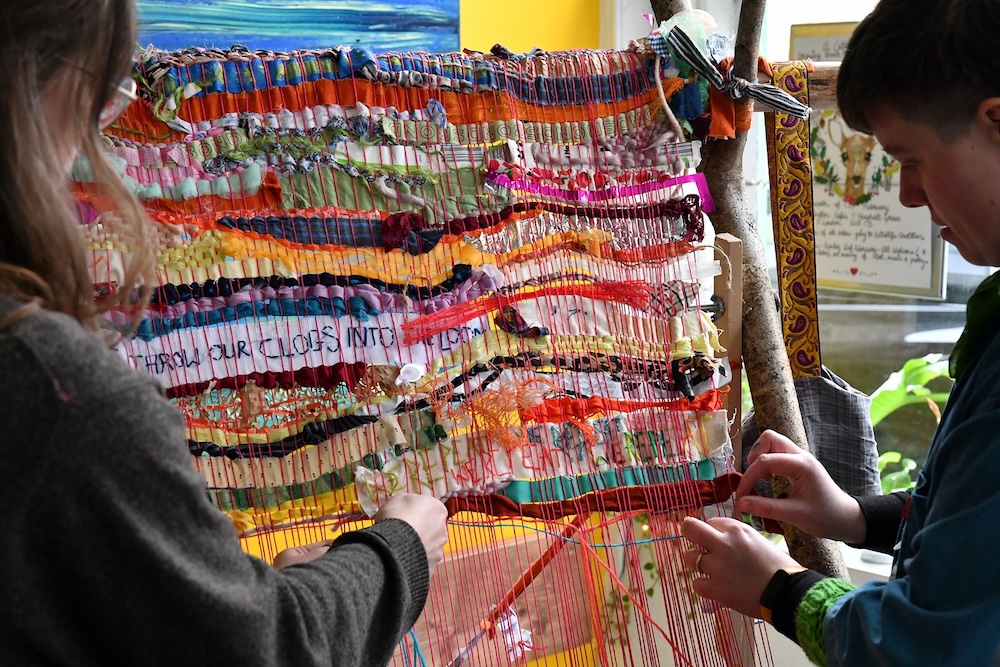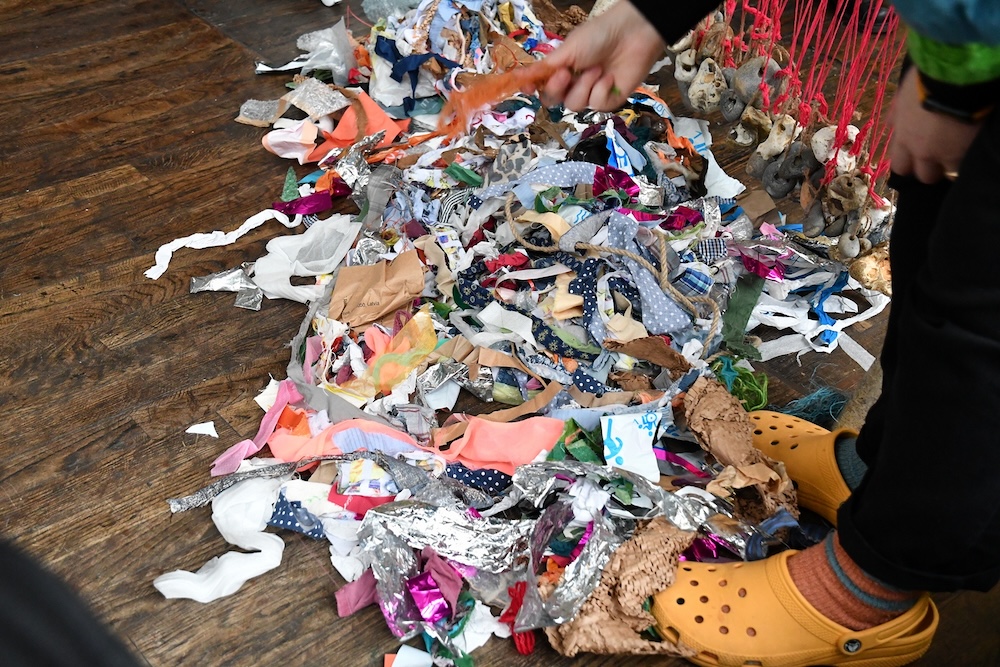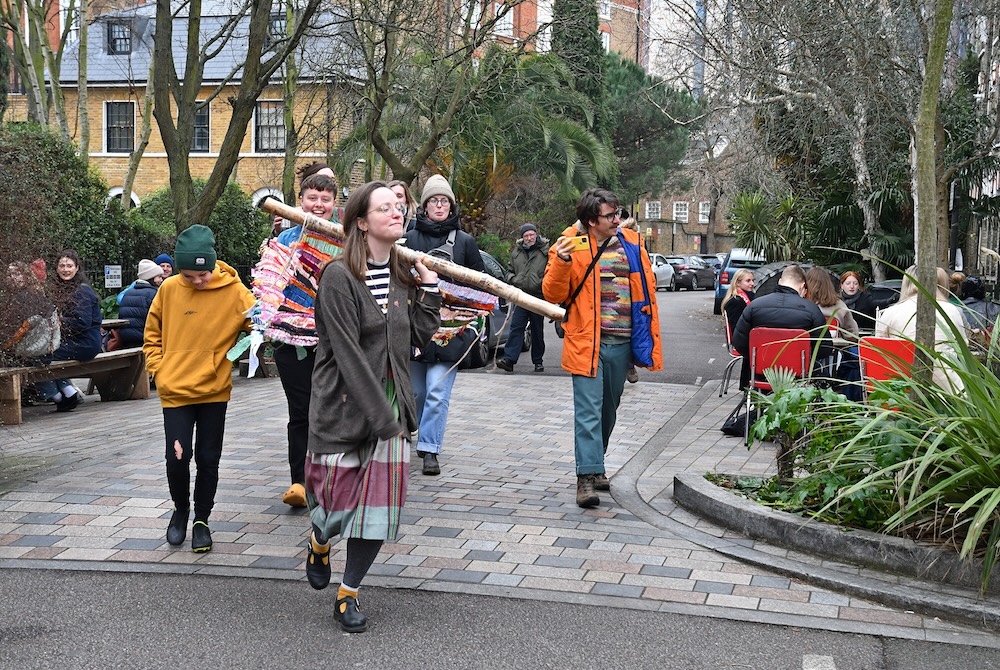A year-long performance piece by Patricia Auchterlonie and Hestor Dart comprising the construction of an iron age-style warp-weighted loom, the weaving of foraged materials and the singing of wordless, improvised vocalisations, ‘Loomeweight’ is the detritus of our late-stage capitalist world woven into the long past, writes Jenny Vuglar.

Photos: Geir Engene
The weight of time, hag-stones — worm holes, sandscrapes, stone grinds — hold down the threads. Stones collected from the gone, from Dunwich and Aldeburgh, from Benacre where the sea tumbles trees into the waves each winter; from Sizewell, its white dome Canute in this disappearing coast.
The discarded plastic, sea worn, the fabric scraps, the string and ribbon that wound around gifts, the rope, the words woven into the whole:
we throw our clogs into the loom
we believe in mistakes
shame is subverted by playfulness
we are in opposition to correctness
we feel our dislocation as loss
we give shelter to failed objects
we hold transient sound in physical permanence
we repeat because we repeat
The detritus of our late-stage capitalist world woven into the long past. The substance of the weaving is at one with the process. Time slowed, the past incorporated, the perpetual newness of consumer capitalism discarded. The voices bounce and echo across the space, a dialogue in sound, a language made of bodies, of the chest and throat and head, the diaphragm that moves, the breath. Not words but sounds before languages, sounds from firelight and the canopy of trees. Weaving material and sound together must be one of the first human activities. The earliest textiles are 34,000 years old, their production was one that bound communities together: the herders or gatherers, the preparation of the material, retting or carding and spinning and then the women (always women it seems) who stand with fingers and shuttle pushing the thread through warps. Penelope weaving the shroud of Laertes. The attic vases, the women beyond the veil mending the rents in the world. Arachne, the mortal weaver challenging the Goddess of war, reduced to eight legs but still weaving; weaving the webs around Greenham, still challenging the Goddess of war. And like the Valkyries who were said to use human gut as warp thread there has also been a history of weaving as prophesy, weaving the fates of the world. Or, as in Hindu mythology, the creation of the world itself.
Here in this small café owned by the community, a co-operative, itself a counter to the monetisation of 21st century London – here the weaving continues, hesitant, at times clumsy, but always radiant, bringing together all of these myths and histories. We are listening to things that are not said, to sounds that evoke all our histories.
Here it begins. Loomeweight had its first long durational outing at the Bonnington Centre in Vauxhall.
The making of the iron-age loom was in itself part of the performance. An iron-age loom, one of the earliest that historians are sure about, pictured on Attic vases as a symbol of virtuous womanhood. Patricia Auchterlonie’s video shows the main stages of the loom-making: foraging for the right sized uprights, drilling the holes, threading the warp, weighing the hag-stones so that they hang equally. All the material is found discards: from beaches, from rubbish bins, from the fast fashion items that litter land fill; from their own lives, left over wool from jumpers, old clothes past mending. They write statements that are fed into the loom.
It is a durational piece that would take more than a year of outings to complete. The first long outing was a whole day session in the Bonnington Centre with people coming in and out, sitting in a meditative silence mostly. They watched; some passing by stayed and settled in for the day. Of necessity there were rest breaks. An audience member offered a leg massage to the singers; the durational is obviously harder than anticipated. The changes are often incremental, the slightest of shifts, the almost unnoticeable movement of the earth. Sometimes the singing became depressingly dirge-like but then, if you are weaving the shroud of the world, some dirge is appropriate.
Collaboration, the loosing of ego, seems part of the ethos of the piece. Each singer responds to the other in a simple call and response structure. There is no pattern, no written notation to follow, each must respond to the other. Listening is as important as sound-making; the sound must be absorbed, brought in before being sent out again, changed, extended, contrasted. There is no leader in this but a weaving of two very different voices. At the same time the act of actual weaving continues, pushing a new piece of detritus against that laid down by the other. A continuous process of bending, choosing material then standing to push it with fingers through the warp threads while the voice continues its own shuttling across the space between.
As an audience it is hypnotic; we are flowing into the moment of creation. As performers it was more difficult than expected to keep that focus and intensity for such long periods. Patricia says at times they found themselves settling into voice patterns, desperate for change. One melodic fragment was banned in the end as it pushed the performance into the predictable. The unexpected, the joy of the accidental, was what made Loomeweight live.
To improvise is to make yourself vulnerable. There is no road map. The voices at times mourning this fragile world, the seas rising, the land washed away; at times strong and defiant holding the transient. The weave is a shroud, is a flag; holds what we have done to the world and the hope that we can be redeemed.
At the Eavesdropping Festival at Café Oto Michelle Hromin described their performance as a ‘pinnacle of intimacy’, a ‘vulnerable, hocketing improvisation … short, sporadic phrases that bounced off the walls of the room, leaving us waiting to see what would be woven and sung in the next phrase’. It is an intimate performance. The singers are not performing for us, waiting for our response, but working with each other to create an experience we act as witness to. It works best without formality, to be able to walk in and out of the room, get coffee, sit on the floor, be part of the sea of material at their feet, the tide line. We are in the house of the weavers. They carry on working, untangling the threads, deciding what comes next. Outside the window we can see the world continuing, the cars, the pollution, the world drowning under the weight of our consumption. Inside we are witness to a new weaving, to what sounds like a surprising incantation, calling into being a space for reflection, for questioning, a space that gives back this intimacy and quiet. They are there, we are in the space they have created. Their own space, but we are invited to enter.

At Café Oto the loom rested against the wall. This was traditional but it became obvious that for a performance it was problematic. It meant the singers often had their backs to the audience, singing into the wall. The weaving was obscured. Before their next outing the loom was made free-standing by adding additional uprights that could be pulled out.
The Starptela Festical in Riga meant more adaptations. The loom was made flat-pack by cutting the legs in half and adding screws and nuts to their inside. It could then be taken apart for packing in a snowboard case and travelling. The loom travelled across borders more easily than people. Performances at Nozstock Festival, Helgi’s Bar with experimental folk artists Milkweed and the Huddersfield Contemporary Music Festival grew the weaving. Both singers had multiple jobs over the year, separate performance schedules where they worked on other people’s projects. This was their homing project that they returned to. Each outing built on the last, not just in inches woven but, in the performance, the way the voices were woven into the making. As the tapestry grew their relationship with it and with each other developed. The loom changed, they changed. Patricia describes it as a ‘year of self-discovery’.
Time was such an important feature of the performance. It was durational in two senses: the actual performances, the longest five hours, and the year-long interrupted duration of the piece. The markers of time, from hag stones worn through centuries, to the luggage labels from its outing to Riga, the wrist bands from festivals: the near time and far time held in the loom. Plastic flutters, rope hangs dull. At the end of each session the weave is pushed tight and rolled over the top beam of the frame. It will not be seen again until the whole is finished.
*
In January 2025 the final loom party was held in the Bonnington Centre, a return, nearly a year since their last visit. The last weaving, the last songs. Taken from the loom the piece is held aloft, the four corners flown. There is a procession. We process. There is singing, people are dancing. This is the square of Hestor’s birth and they own the space.
The Square has a history of processions; processions, festivals, art happening. From piping the stilton with medieval bagpipes to fire jugglers in a midwinter renewal. Forty-five years of art making as community building. And here we go again, the next generation. We dance creativity and joy into the paving. This is how it is, not proper dancing, a walk with a lilt in it, a catching up and falling behind walk as we spin out to talk to someone or wait for someone to grab a coat and join. A laughing, chatting dance, sped along but not marched by singing. People come to their doors and windows to watch. Spontaneous as everything is at first. Not framed by anything, just the joy of this long doing, of the making, of holding it aloft, this bright hope rescued from the discarded.

Coming soon: LOOMEWEIGHT II, which has involved building a whole new loom — this time based on a backstrap design. At present Patricia and Hestor are developing new musical material to work with the new loom.
*
Jenny Vuglar’s latest work appears in ‘Dark Mountain’, ‘Echtrai’ and ‘Amphibian’. She has a small book due out this year from Paekakariki Press, ‘Wrentham: 72 seasons’ and a pamphlet with Hearing Eye Press, ‘This Blue Mantle’.